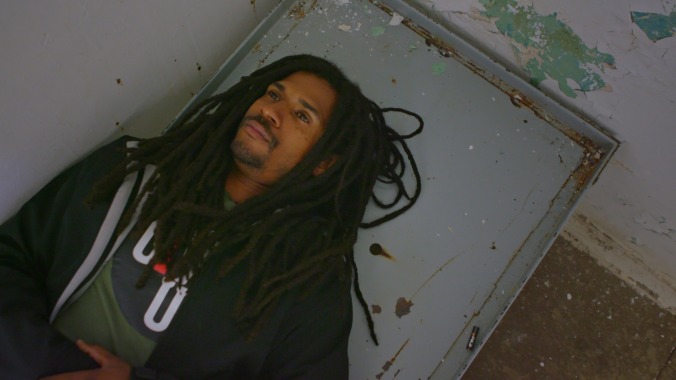Although he has never been convicted of a crime, Mike Africa Jr. has served significant time. Debbie Africa, at the outset of her prison sentence, gave birth to Mike Jr. at Philadelphia’s House of Corrections, while his father, Michael Africa Sr., served a concurrent sentence. Africa Jr. wouldn’t know of the existence of his father until the age of 5, when he visited him in prison. Smiling faces and prison gates fill their family photos. And every year—for 40, in fact—Africa Jr. has combed through boxes of court testimony searching for evidence in his parents’ favor, pausing his life for their parole.
Debbie and Michael are members of MOVE, a Black organization founded by John Africa in Philadelphia in the fight for Black liberation. His disciples, who all assume the surname “Africa,” practice a doctrine that mixes Lockean and Transcendental tenets: do not eat processed foods; do not wear extravagant clothes; and enact no harm upon any of Earth’s creature, but defend oneself and others if necessary. During the 1970s, their compound, which occupied two adjacent houses on a residential block, teemed with rescue cats and dogs and barely clothed children. Philadelphia Mayor Frank Rizzo—a former police commissioner who by all accounts was a virulent racist—targeted the group through aggressive policing. A great deal of latitude was extended to cops to exert extralegal force upon Black and brown people, and it marked the environment for the fight between MOVE and Rizzo, and led to a disastrous bloody raid that landed Africa Jr.’s parents in prison. Director Tommy Oliver’s gritty documentary 40 Years A Prisoner not only recounts the violent events that led up to the raid, mixing eyewitness testimony with gripping news footage, but in heartwarming fashion, also presents the tireless pursuit by a son to free his parents.
Oliver divides his film into four narrative tracks, the first being Africa Jr.’s present-day struggle to win his parents’ parole. Africa Jr. gives face to how the prison industrial complex affects not only the incarcerated but also their loved ones. In one harrowing scene, he visits his mother’s former cell at the House of Corrections. The room, a generous label to describe the cramped area, fits two beds, but is no bigger than the space of a pair of phone booths. As Africa Jr. extends his arms, his fingertips can touch both walls. He also lies in his mother’s former bed, wondering aloud what she might have felt all those years ago. The scene is oddly similar to one in Invictus, when Francois Pienaar (Matt Damon) visits the cell of Nelson Mandela. Considering that Africa Jr. believes his parents are political prisoners, the comparison isn’t too far off. The more bureaucratic hurdles we see him encounter in the parole system, a seemingly capricious board that has denied his parents eight times, the less alien the sentiment seems.
Oliver also employs eyewitness testimony ranging from accounts of journalists to MOVE members to the organization’s own legal team. A divide is evident. Many of the white participants, especially the former cops, describe MOVE by their appearances: They wore dreadlocks; they were shirtless, loud, and foul-mouthed. The white talking heads never engage with these Black men and women as people. They surmise MOVE’s aims as impractical, and in starker terms, they refer to the group as a cult. The organization could be a cult, and John Africa is a shadowy figure, but one of the flaws in 40 Years A Prisoner is Oliver’s inability to define the misunderstood hippie sect. Instead, we circle the periphery but never quite understand the organization. Oliver also uses post-raid video testimony given by members of MOVE to the Philadelphia Special Investigation Commission, along with news footage documenting the events leading up to the infamous night. These included a baby dying by police actions, the group installing a parapet and brandishing weapons for self-defense, Rizzo threatening to drag the group out of their homes by their necks and MOVE threatening in kind, cops creating a blockage to starve the MOVE members out of their compound, and the group being promised a 90-day extension to evacuate, which ever so briefly promised peace.
Each major- and microaggression had the power of a match in a bone-dry forest, their embers culminating in the explosive 1978 raid on MOVE headquarters. The fragile peace between Rizzo and MOVE disintegrated when the mayor proclaimed his intention to tear down the latter’s headquarters on the 91st day of the 90-day extension. So on August 8, 1978, Philadelphia police arrived at the organization’s headquarters armed with Uzis, riot gear, bulldozers, and a battering ram while the men, women, and children of MOVE took shelter in their building’s basement. The eyewitness testimony from former cops, members of MOVE, and journalists alike are as chaotic as the event. Consuela Dotson, a MOVE member, claims to have heard the police order, “Kill anything that moves in here.” Two retired officers say the group had weapons, which instigated the first shot fired, and the shoot-out that led to the death of officer James J. Ramp. In a bid to literally drown the organization, city officials pumped thousands of gallons of water into the MOVE basement. And even after the group’s surrender, six officers took the unarmed, shirtless Delbert Africa and kicked him while he lay defenseless on the ground.
The tragic day might have been lost to memory, rewritten by the authorities to cast the final stones against MOVE, if not for the harrowing footage caught by the media. Some images become seared into the mind: cops and firefighters army-crawling across the drenched street, the torrential water shooting from the fire hose with a cannon’s force, and Delbert lying in the fetal position, on a secluded street corner, as ruthless cops kick at his skull. The footage, shot from multiple vantage points—across the street from the headquarters, within neighborhood homes—is arresting. By way of their stylized editing, through split screens, Oliver and Joe Kehoe stitch together the aftermath: archived newscasts leading their coverage with the death of Officer Ramp, the refrain of news anchors and public officials commending the police for their “restraint,” and the ensuing trial, when a judge stacked the odds against MOVE. The most horrifying component is how familiar the whole affair remains. This summer, the footage of George Floyd’s death repeated without pause, and the cry for justice regarding Breonna Taylor’s death echoed just as loud. Instead of prosecuting the officers involved in Taylor’s death, authorities worked to prove her criminality.
Although Africa Jr. mourns how jail suspends a person’s life, in the pauses, Oliver’s brutal documentary discovers upbeat notes. Still, large questions remain by the film’s conclusion: What is MOVE? Is it a cult? In what form does the group exist today? The gaps give Oliver’s film a sense of incompleteness. But the story he does construct makes 40 Years A Prisoner another reminder of the repetitious history of American racism, and the prisoner and police reform still required to avoid the same mistakes.






























![Rob Reiner's son booked for murder amid homicide investigation [Updated]](https://img.pastemagazine.com/wp-content/avuploads/2025/12/15131025/MixCollage-15-Dec-2025-01-10-PM-9121.jpg)











